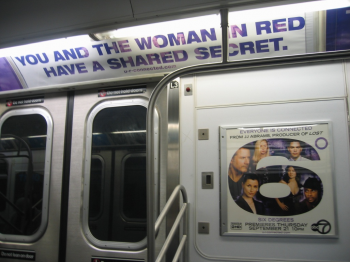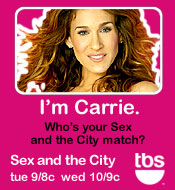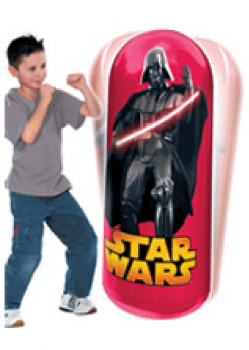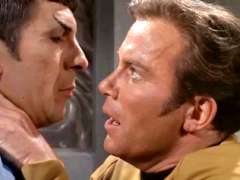Mommy, Is That a Boy Text or a Girl Text?
by: Jonathan Gray / Fordham University

How does a text become a boy or a girl? The supplying or withholding of Y chromosomes is not a key task of a show-runner, nor is it the power granted to a network by winning in the Nielsens; therefore, how is it that television shows so quickly become known as “guy’s shows” or “chick flicks?” In this column, I want to argue for the significant role of promotional materials and surrounding paratexts in giving us virtual ultrasound scans, telling us gender before a text is even born, so that, to carry the metaphor further, by the time the text arrives, many have already ordered the blue or pink wallpaper, and readied their vocabulary for talking about the text.
To say this is not to deny that texts aren’t at times gendered beyond the promotional, paratextual material–-given the long history of certain genres attracting much of their audience from one gender, television shows will often be quite prominently gendered. Thus, for instance, Gilmore Girls is about a mother and daughter relationship, focusing on their respective romances and talk, hence gendering it female in terms of generic history. 24, by contrast, is about a guy who needs to kill, torture, run a lot, cause explosions, and scream very loudly, all on a tight timeline, hence gendering it male in terms of generic history. And let me be clear from the outset that individual viewers can of course read a text against gender, but as I will explain later, even that act often requires the assistance of paratexts to “re-gender” (or to queer) the text.
Case in point regarding promotional materials, though: Six Degrees. If you’ve seen it, forget that you have for a moment. And join me as we go back in time to New York City in August 2006, before it was released. ABC plastered numerous subways with provocative ads that hovered above one’s head, saying things like “The man by the door will someday be your boss” or “The girl across the aisle is flirting with you” (see image below). While an ad lower down in the subway car explained the connection to a new show from ABC, a car-full of people (as is normal for New York) would obscure the ad for most. Instead, the higher-up ads offered a web address: U-R-connected.com. At the website, more oblique references to fated connection appeared (see opening photo) before it asked six questions so that it could help one “find a connection.” Questions answered, eventually the site suggested a personality likeness to one of the primary six cast members, then advertised the show with a clip.

This campaign, I would suggest, gendered Six Degrees female. The ads’ references to fated connection in New York City alluded to a mainstay of the romantic comedy genre – namely, serendipity in Manhattan (think Sleepless in Seattle, Kate and Leopold, When Harry Met Sally, and Serendipity), while they simultaneously drew from the rhetoric used to sell online dating sites (of which “U-R-connected.com” certainly sounded like one) to busy urban women. The questions on the website were written in classic Cosmopolitan questionnaire-speak, such as, “Who Are You? I am my work; I am the sum of my experience; I am my future; or I am my contribution.” And the promise to link one to a character referenced the Sex in the City “I’m ….” craze (see image below), thereby promising to grab that show’s baton and run away with it as the show for sexy, urban, chic young women, and suggesting that Six Degrees would similarly place its thumb directly on the lived experience of such women. Thus, the advertising heavily referenced “female” genres and texts – the romcom, Cosmo, Sex in the City.

Equally important, very little about the ads called to straight men. The attractive female cast, for instance, was muted in the ads, ghosted behind the ads’ lettering, but looking more like happy customers from a dating company than lures for male viewers or even male customers (compare to the below ad from Lavalife, also prominent in the New York subway). And though the lower-down (ie: often hidden by people) ad mentioned producer J. J. Abrams, the mastermind behind the very guy-friendly Lost and Alias, nothing more was made of his role. Television ads that mentioned Abrams alluded more directly to his past Felicity, thereby once more hailing female would-be viewers.

When it finally hit the air, Six Degrees struck me as a little confused as to what it was or what it wanted to be in general, and not just at the level of gender. But it certainly did not seem unequivocally “female,” making me wonder why the ads tried so hard to gender it as such. For my purposes here, though, what it is, was, or could’ve been is beside the point. Rather, I propose that with its promotional materials ABC made the show “female” before it was released.
Yet it is by no means alone. Recent subways ads for Showtime’s The Tudors similarly hailed a female or gay male viewer. Jonathan Rhys Meyers looks seductively at the camera, while the wording and posing of the ads allude almost exclusively to romantic intrigue, with little more than the presence of King Henry VIII’s sword to suggest any action (though, of course, in Freudian terms, a man with a big sword represents much more than action), and little to suggest political maneuvering. Perhaps, though, Showtime felt the need to insist upon The Tudors’ female-friendliness, given their earlier success in framing the show as Rome-with-more-wives, and given Rome’s prevalent male gender coding.
So go the ads pre-release, but we might also consider the role of promotional, paratextual material in determining gender after release too. Here, the seminal example is Star Wars’ army of toys, all for boys (see below). The old FAO Schwarz in Manhattan required one to walk through a corridor of G. I. Joes before arriving at the Star Wars action figure section, fully decked out with blue and black, and showing battle-scenes all around. On the face of it, Star Trek would seem no more or less male or female, even though its female fan following is well known – if anything, the slightly effeminate Luke Skywalker and the bold Princess Leia may have been expected to rope in more women than Captain Kirk and Mr. Spock. But Star Trek never had a male-focused marketing blitz as did Star Wars.

Of course, what Star Trek did have–as all cultural studies scholars know–is slash fiction writers, who made Kirk and Spock lovers (see below), therein showing how paratextual gendering, queering, and–dare I say–Butlerian performances of gender, can become embedded in paratexts. At the textual frontier of the paratext, audience members can and occasionally do resist a text’s apparent “sex.”

To return to the metaphor with which I began this column, as this column hits FLOW, we’re now at the end of the first trimester of the upcoming Fall season’s pregnancy; and thus the ultrasound scan will soon start to become more decisive: summer ads will be starting soon, telling us whether new texts are boys or girls. Yet just as I find it somewhat depressing when soon-to-be parents run out to buy the Tonka trucks and Thor’s Hammer or Barbies and Little Princess’ Tea Set, it will also be somewhat depressing to see paratexts and promotional material similarly gender the new shows before they’re born.
Please, I welcome comments.
Image Credits
1. Screenshot from U-R-Connected.com
2. Personal photo taken by author.
3. Image from DanielleMarie.org
4. Image from JustToys.com
6. Image from AgonyBooth.com
Jonathan,
you’re also raising interesting issues about paratextual interpretations. Ads clearly affect our reading, so that not only may the “wrong” gender never actually get to the text, they may (mis)read it through the gendered paratextual material once they’re there.
Isn’t it interesting, though, that fan fiction tends to invert gender pretty much across the board? Forget the subversiveness argument and even the queering of the characters and the reader/writer–if your argument holds, then slash queers the text by altering the gendered paratexts, replacing SW figures with erotic romances, de-emphasizing the episodic cop/agent/space explorer plots by foregrounding the emotional arc.
And clearly we return to the gendered ads when pimp our own: offering alternate paratextual material that reinterprets so that the male ads are superseded by female ones (usually outside the capitalist economy, however!).
Jonathan’s piece is an interesting analysis of the impacts of the increasingly segmented TV marketplace, particularly as producers and advertisers become perhaps more concerned with effective narrowcasting than quality programming. Beneath the surface of these clearly-gendered campaigns is the notion that these marketing departments have not thought critically about the effect of essentially “shutting out” half of the audience based on their gender. By clearly marking a text as a “girl” or “boy,” the promotional materials are not only making a bad business decision (by turning off potential viewers) but also making problematic suggestions about what the “male” or “female” viewer wants to see.
I know many straight men who watch Sex and the City, for both the sexual content and potential insight into the minds of women (we will leave the notion that the show might actually provide such insight to the side). Where was the promotional campaign teasing men to find out what women say about them in their absence?
Furthermore, as a female viewer who counts LOST, CSI:, and Numb3rs as her favorite programs, I seldom ever find myself drawn in to traditionally “female” shows. The more a program’s promotional material tries to appeal to my gender, the less I am inclined to watch. Frankly, I find it demeaning to be appealed to via my chromosomes.
Particularly now, with network hour-long dramas so expensive to produce that many new shows are yanked after only 3 episodes for “failing to find an audience,” perhaps this gendered appeal is failing, by distancing half of the viewing public before the show even airs. By creating expectations that a viewer might not like a show because of his or her gender, this further alienates the audience necessary for the show to succeed.
Jonathan’s piece does an excellent job of explaining how this gendered appeal is functioning (and potentially failing, in the case of 6 Degrees). Perhaps, however, the producers need to further consider the impact of this appeal, and the ramifications of creating expectations based solely on problematically narrow gendered appeals.
In the case of the Tudors, I would argue that Jonathan Rhys Meyers’s career contributes substantially to the gendering of the text. This well-done fanvid is a great demonstration of how queer Meyers’s choice of roles has been at times; I think selling Meyers to a straight male audience at this point would be a bit difficult and possibly alienate some of his established following.
I’d be interested in looking at how this gendering works with different audiences. For example, are women and gay men more likely to read against the gendering or a text than straight men are?
Though I am reluctant to suggest the following as the only explanation for the phenomenon Gray posits, I wonder if some of the “blame” for the gendering of paratext can be placed on an uncertain audience. That is, as we (literally) look to the television to find out what to watch–by way of the ratings that appear in the corner of the screen, the audience-based viewing suggestions featured on the TV Guide Channel, the selections taped on our behalf by TiVo–we participate in the development of a segmented audience. As our viewing patterns are informed by these features, we use these behaviors to construct our own identities as television watchers. This can be accomplished as an additive or subtractive process, an example of which is provided in Katherine’s comment (above). Katherine describes a process of selection that is, in effect, de-selection; she writes, “the more a program’s promotional material tries to appeal to my gender, the less inclined I am to watch.” If this is the case, her selection (and the selection of others like her) would be based not on the targeted promotional material but on an attempt to subvert the promotion. I realize that this divides viewing selection into an uncomfortable binary–either you watch what is targeted toward your gender or you watch what isn’t targeted to your gender–it’s interesting to see how the same descriptive vocabulary effects opposing results.
I’m pondering Katherine’s comment about maybe this paratextual gender coding has “failed” in relation to how television, along with a bunch of other media and genres, have become so narrowly targeted for audiences. In other words, could the gender coding pre-release para-texts be a method for trying to seduce a wider audience? Is that giving advertisers too much credit. Instead, along with Katherine’s point, the advertising agencies don’t yet know how to juggle the hyper-target advertising with advertising that blatantly invites against the grain viewing in an attempt to gain more viewers. Clearly this moves beyond simple gendered terms (not that they are ever simple…so maybe binary gendered terms).
For example, the pre-advertising for The Black Donnelly did nothing for me. Although I agree that The Godfather is a canonical texts and has major cultural capital, it’s generally not my genre. Now…if just one of those advertisements I saw hinted at how the show was going to be creatively narrated (ala The Usual Suspects), they would have had me…at least for the first episode. Instead, the only reason I watched it was because my partner and his daughter wanted to. I then was able to go running to the office the next morning and share with my colleague how they were doing fun/ky narrative stuff that he likes to write about (http://flowtv.org/?p=87).
I guess what I’m thinking is that maybe that the continued hyper-focusing of media, genres, and audiences will further contribute to the more complex narrative “reading” skills that Craig talks about in his articles (one mentioned above). For anyone to break out of their self-identified hyper-focused media/genre, they’ll have to learn to read against the grain.
Thanks for the great discussion. I should add a further case, though, that I find somewhat amusing/perplexing: The Simpsons. When I did my audience research on the show, and ever since, *everyone* I’ve spoken to about the text sees it as parodic/satiric (even 8 year olds, who often proved remarkably skilled at picking up on its multiple ironies) … yet sees themselves as part of a small elite who “get” it. So we have two interesting things going on here: (1) many people’s enjoyment of The Simpsons at least in part relies upon their feeling of being in a smart elite who appreciate its “deeper” meaning; and (2) yet seemingly everyone is in that elite. I think the advertising for the show plays a significant role in developing that situation, since American advertising rarely focuses on the parodic-satiric, meaning that its publicly FOX-“preferred” reading is *not* parodic-satiric by most appearances (meanwhile, non-American ads can often focus on its parodic-satiric elements, since now the assumed-dumb American audience fill in the role of those who don’t “get” it). I can’t really flatter FOX’s marketing team with intending to produce a “cult” audience for a very mainstream product in such a way, so I’m very wary to ascribe intent, but this is a prominent example of how audiences can really work against paratexts in odd and interesting ways.
I disagree with Gray who dislikes the idea that shows are gendered through promotions/advertising even before they are premiered.
In contrast, I believe that shows need to gender their promotional material even before the show premieres. If producers have a clear focus on what type of audiences they want to target (those who associate with feminine characteristics, those who associate with masculine characteristics, or those who relate to both) than their show will reflect that specified audiences through their narratives, editing styles, sound design, etc.
In order to attract the most viewers in their specified audiences, producers need to create “boy or girl” ads that will attract their ideal audiences.
Although not all audiences of T.V think alike, some of them will probably dispute my claim and argue that gendering a promotional campaign before a show comes out restricts the potential viewers that could possibly enjoy the shows if gendered advertisements did not turn them away.
On the one hand I agree with these audience members that gendered ads will be ignored by viewers who do not relate to those particular gendered semiotics. But on the other hand I still think that if the ad reflects the gendered content and semiotics of the text, than the audience member who pays no attention to the semiotics of the ad, will similarly pay no attention to the semiotics of the show and vice versa.
If many people disagree with me, please continue the argurment of this intriguing analysis that Gray has brought up.
Television and Advertising have with them a long history of gender ideologies. It is interesting that you bring up Star Trek, as we recently read an article and watched the documentary “Trekkies” in my TV class. The article explained that 90% of fan-fiction is written by women, primarily for women. This is because, the article I read explained, that men and women have been socialized to read in different ways: men more-so in the organization of the narrative and women on the relations between characters. Women create such texts, that are in essence, “designed for them”, like many existing texts and ads.
TV and advertising repeats gender lessons found in society. All sings found in ads and shows have with them codes, that we as signifiers create and apply meaning to. This is how such gender ideologies are constructed.
Whether or not this is a good or a bad thing is debatable, and I can see both sides of the argument. However, it cannot be denied that texts specifically designed to attract simply boys or simply girls does not exist, and often times, especially in the case of toys for children, this can be annoying.
Jonathan Gray is definitely correct about how ads are gendered to create specific audiences for certain shows. I do not necessarily agree with it. Though shows appeal to different viewers There are plenty of shows out there that cater to both female and male viewers. I personally never become interested in a series through commercials since I do not watch very much television because commercials are a waste of time. I get all my information from people who have seen shows and tell me about it. Why trust an ad that is selling you the gender of a show when you can ask people of either gender you know about shows and play off of that. If a guy friend tells you a show is good it is gendered as male, but it is gendered by a male and not an advertisement that just wants to gather specific groups to watch their episodes. Are there bi-gendered advertisements? For example, a show like The Office. How would one spin an advertisement for this show. Are all ads gendered or are some after even more specific markets like gay men and lesbians? The smaller the group you try to get to watch your show most likely leads to less viewers and an ending that may involve cancellation. Why just focus on half the population or less when there are a lot more people out there. These ads seem to use the same stereotypes that are displayed in the shows. We already know they are trying to get us to buy, watch, or get involved with something, so why can they not just try to get us all in one big swoop? They could use more specific advertisements and put out several at the same time aimed at several different groups and use the ads to hit hard on specific appealing points for each group. This way a large amount of people are affected from many different demographics in an effective way.
Excellent examples of how producers often gender their “products”, but I feel that this article has a bigger point that in does not directly address. What defines “boy” or “girl”? By viewing certain messages as gendered, are we continuing restrictive ideas of gender? What is abundantly clear to me, is the connection with these imposed ideas of gender and what is true. Simon de Beavoir argues that one is not born a woman, one must must become a woman. The idea is basically, that there are natural human qualities that mark us as different, but outside forces have separated the certain idea into a binary system of gender. This perpetuates an expectation of behavior if one is to be viewed as a boy or girl. My argument, and many others, is that the current system we operate under for understanding gender is restrictive and problematic for those who do not fit within society’s definitions.
So when we view something as female, is it because that is what women do? or is it due to the fact that from before birth we are encoded with typical ideas of gender. By being exposed to these ideas before our cognitive skills are developed, we view this system as natural. Only by questioning its uses, such as gendering a text, can we begin to understand this issue.
This is an interesting piece about gender placement in text. But there are also gender in fonts as well as text. Shows that are directed toward male viewers are usually have blocky or simple fonts. The blockyness of titles is like a metaphor for the masculine body, broad and big. The simpleness of the font could also attribute to the masculine trait, according to Denise Kervin’s article “Gender Ideology in Television Commercials”, of being emotionless and expressionless. Such shows that are considered guy-friendly shows like Lost and Alias have masculine fonts have such fonts that fit masculine traits. The opening title sequence for Lost is just Blocky white letters slanted and fading into a black background. The blockyness of the letter fit the metaphor of a masculine body, while the title fading into darkness is like a symbol for the mysteriousness masculine trait. Alias is another show that is extremely guy-friendly. While some women might watch it because it has a female heroine as the main character, it is ultimately for men because, Sydney Bristow, the main character, manages to save the world while looking sexy in scantily clad clothing. The male gaze is ultimately focused on her. The opening title further shows that the show is made for men. The letters are also a bit blocky but a bit more curved. Each letter is however dented with uneven ridges. This could signify the ruggedness of the masculine trait.
With girl-friendly shows such as Sex and the City and Gilmore Girls, there is a drastic change in fonts. Gilmore Girls’ opening title sequence is much curvier then show titles like 24, Lost, Alias. This of course can be a metaphor for the curves associated with the feminine trait. Sex and the City also had curvy letters. It’s bulky, but all the letters are in lower case so that certain letters like “A” and “T” are not sharp but rounded, like the traits of a female figure. Sex and the City also changed its title from white, light gray, and dark gray, to glittery hot pink letters when it went to the big screens. With Text, it takes a bit of analyzing to tell if it directed toward male audiences or female audiences, but with Fonts, sometime the message is quite clear for who it’s directed toward.
Great Post! You have given an excellent example about gender placement in text and how producers often gender their “products”, but I feel that this article has a bigger point that in does not directly address. What defines “boy” or “girl”? By viewing certain messages as gendered, are we continuing restrictive ideas of gender? One more example you gave is Star Wars army of toys. Its very interesting post. My son loves that ad of StarWars toy.
Thanks alot – your answer solved all my problems after several days stgrulging
While a text can be dominated and directed to a specific gender, does it necessarily affect a text’s value to the consumer? Obviously it might be uninteresting or discouraging to engage with a text for another gender, but I bet that’s not always the case. In fact, I bet despite the focusing of a text’s attention on a specific gender, there are many other gendered fans that appreciate the text just as much. While it would be nice to work outside of the hegemonic need to gender label everything, there is always the possibility to ignore the hegemony. Producers of texts want their text to be consumed indiscriminately. They probably have an intended audience, but it’s doubtful that they want that to be their only audience.
I say consume any and all interesting texts, and let gender labels figure themselves out. The ultimate interaction with the text falls to the consumer, and there are no laws to tell them how to consume it. Just suggestions. However, these suggestions can lead merchandisers and similar folk astray from the path of indiscriminate product creation. It is indeed a sad fact that texts can be gendered so easily and so immediately after conception, but the text still exists. It may not be the same text as it could have been, but it exists and is available for engagement with people of all genders.
Pingback: Text Von Just A Girl | Text a Girl
Pingback: Flirt Sms In Hindi For Girlfriend 140 Character | Text a Girl
Jumping off of Graham’s comment, although I agree the consumer’s interpretation of the text is the final say, the problem lies within the exposure to such texts, and most importantly what a more impressionable consumer will interpret and “learn” via gendering of these texts. Contemporary culture is learned via media image. In the information age, most consumer’s jump to the quickest, most simple categorization, if only to survive the onslaught. I believe that gendering at the marketing level leads to identity confusion. Why do I like the tudors, is it because the men are sexy? But I don’t like men, do I?
In a vacuum the text would stand alone, but when given different markers and labels I believe this leads to major gender Identity and sexual identity confusion. The more a viewer is lumped into a category, the harder it becomes to understand one’s true identity outside of categorization.
Although I entirely agree that many ads for television seem very much geared towards attracting male or female attention, as each is stereotypically conceived of, I found myself wondering what an ungendered ad would look like. These posts have mentioned color, font, and shape as well as text. Although I would love to see more ads of this kind, it seems that designing an ad to create a gender-neutral message would be rather difficult, if you are trying to take into account the ways in which hundreds of thousands of people will perceive the ad. We have built up systems of observation from exposure to gender dynamics in media. It seems like a chicken and egg cycle of assumptions, between audience and advertisers.
Perhaps the root of the issue can be located in the assumptions made by television producers about what will appeal to certain consumer demographics, rather than the choices made in designing the ads specifically? Are the media producers themselves determining what delineated gender category they are creating the show for, and is that reflected in the ads, or do the ads create the gender lines that media producers must then paint within based on the audience they have attracted or can attract? Media chicken, or media egg, and who can break the cycle?